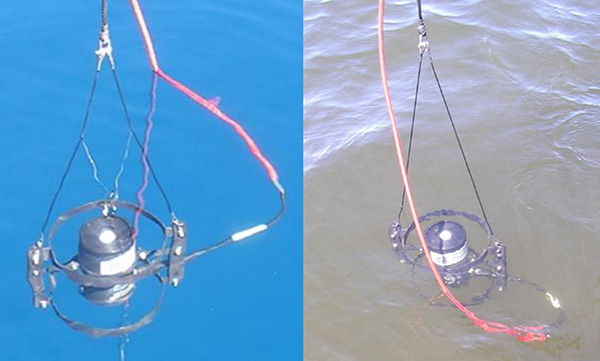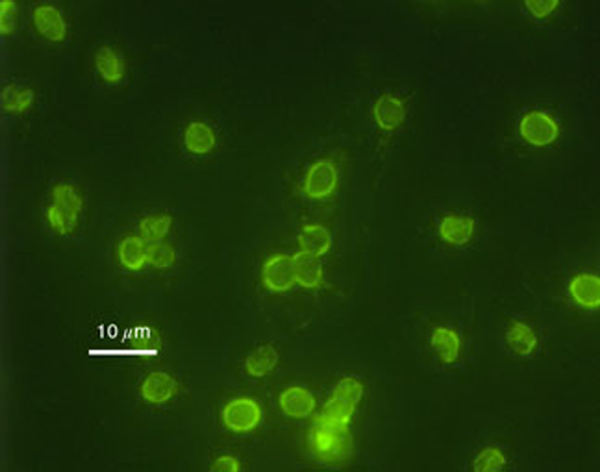

Climate change could decrease sun's ability to disinfect lakes, coastal waters
An increase in extreme rainfall makes it more difficult for UV light to kill pathogens

A submersible radiometer that researchers use to measure UV penetration is shown in clear water in Lake Tahoe (left) and water clouded with particles and dissolved organic matter. (Photo by Craig Williamson)
By Laura Snider, courtesy of National Center for Atmospheric ResearchOne of the largely unanticipated impacts of a changing climate may be a decline in sunlight's ability to disinfect inland lakes, rivers, and coastal waters.
This impact could lead to an increase in waterborne pathogens and the diseases they can cause in humans and wildlife.
A new study led by Miami University researchers and published in the journal Scientific Reports outlines how a rise in the amount of organic matter washed into bodies of water can stunt the ability of the sun’s pathogen-killing ultraviolet rays to penetrate the water's surface.
Scientists already have measured an increase in "browning" of the world's waters, a phenomenon caused by more organic matter washing in from the surrounding land. This trend is expected to continue as a warming climate leads to more extreme rainfall and thawing permafrost, both of which contribute to the problem.
In the new study, researchers analyzed water samples and used a model based at the National Center for Atmospheric Research (NCAR). They quantify, for the first time, the impact of dissolved organic matter on the potential for UV radiation to kill pathogens in the water.
"Much of the research emphasis up to this point has been on the browning itself, not the ecological consequences," said lead author Craig Williamson, a professor of biology at Miami and Ohio Eminent Scholar of Ecosystem Ecology. "We were able to determine that in some cases, browning is decreasing the ability of sunlight to disinfect water by a factor of 10. This could have serious implications for drinking water supplies and coastal fisheries across the globe."
The study involved multiple scientists from different disciplines who serve on the United Nations Environment Programme Environmental Effects Assessment Panel (UNEP EEAP). The data collection and modeling foundations used in this study were funded by multiple grants from the National Science Foundation.
Cryptosporidium parvum is a common contaminant in surface waters and an indicator species for protozoan pathogens in drinking water. It causes cryptosporidiosis that can lead to chronic illness or even death. Solar UV substantially reduces (10-fold or greater) its in vitro growth rate. In this study, natural waters with higher dissolved organic matter concentrations reduced solar UV inactivation, with the extent of the inactivation depending on the source water and nature of the dissolved organic matter. (Photo by Sandra Connelly)
Quantifying the impacts
For the study, Williamson and his colleagues relied on water samples collected from lakes from Pennsylvania and Wisconsin to Chile and New Zealand. Water samples were tested to determine how much dissolved organic matter each contained as well as determine the wavelengths of light — including ultraviolet wavelengths — absorbed by that organic matter.
Then-NCAR scientist Sasha Madronich calculated the solar inactivation potential (SIP) for each lake. SIP is an index of the expected disinfecting power of UV light in a particular body of water based on its dissolved organic matter and other characteristics.
He used the Tropospheric Ultraviolet-Visible model — which simulates how UV light is scattered and absorbed as it passes through Earth's atmosphere — to determine how much UV light hits the surface of the lakes throughout the year.
Madronich also analyzed reflection and refraction off each lake's surface to calculate how much light penetrates the lakes and how deeply it reaches.
Because scientists already have some understanding of which wavelengths of UV light are most damaging to which waterborne pathogens, the scientists were able to use the model output to calculate the SIP for each lake. In some cases, they also calculated the SIP across different parts of, or for different time periods in, the same lake.
The results allowed scientists to quantify the impacts of dissolved organic matter. For example, the summertime SIP for one lake in northeastern Pennsylvania — which, along with other regional lakes has undergone significant browning in recent decades — dropped by about half between 1994 and 2015.
Human, weather and seasonal factors
In California's Lake Tahoe, the SIP in the relatively pristine center of the lake can be as much as 10 times greater than at Tahoe Meeks Bay, an area at lake's edge that is heavily used by humans and has a much higher level of dissolved organic matter.
The scientists also showed how SIP can dramatically decrease after a heavy rainfall using water samples collected from the region where the Manitowoc River in Wisconsin flows into Lake Michigan, which supplies drinking water to more than 10 million people. Modeling based on samples taken before and after a strong storm moved through on June 21, 2011, showed that the SIP may have dropped by as much as 22 percent due to the extra dissolved organic matter that washed into the area in this single storm event.
The results for all lakes also showed a significantly stronger SIP during the summer — when the sun is higher in the sky — than winter. Lakes at higher elevations also had higher SIPs during all times of the year.
Working across disciplines
The study highlights possible challenges for water supply managers and public health workers as the climate continues to warm and extreme precipitation events become more common. Not only does an increase in dissolved organic matter make it more difficult for sunlight to disinfect bodies of water, it also makes it more difficult for water treatment plants to work effectively, Williamson said. In the United States, 12 to 19 million people already become ill from waterborne pathogens annually.
The research also underscores the importance of working across scientific disciplines to fully understand the impacts of climate change, said Madronich, an atmospheric chemist.
"What happens in the atmosphere affects what happens in lakes," he said. "These are not separate compartments of the world. These things are all connected."
Other co-authors of the study are Aparna Lal and Robyn Lucas (The Australian National University), Richard Zepp (Environmental Protection Agency), Erin Overholt (Miami University), Kevin Rose (Rensselaer Polytechnic Institute), Geoffrey Schladow (University of California, Davis), and Julia Lee-Taylor (NCAR).
The University Corporation for Atmospheric Research manages the National Center for Atmospheric Research under sponsorship by the National Science Foundation. Any opinions, findings and conclusions, or recommendations expressed in this publication are those of the author(s) and do not necessarily reflect the views of the National Science Foundation.

